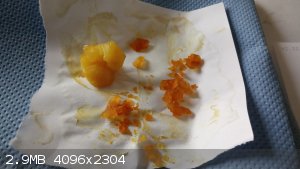
dome13 - 25-2-2021 at 08:08
Hello!
I am currently synthetising p-aminobenzoic acid from p-nitrobenzoic acid. The reducing agent was SnCl2 x 2 H2O in absolute ethanol. After refluxing I
diluted with water and basified with NaHCO3. This caused a white precipitate, tin(IV)-carbonate. After vacuum filtration I placed the filtrate in a
warm place in order to dry. On the next day I was suprised, that the volume was drastically reduced and it got a yellow-amber like color. It is a side
note what I found interesting: immeditially after filtration, it has a physical properties like vaseline or cold fat.
So, my quiestion is, is this how tin(IV)-carbonate supposed to look like after drying, or is it something else?

njl - 25-2-2021 at 08:19
I don't think tin carbonates are stable and instead decompose into oxides. You probably have a tin oxide/hydroxide contaminated with your target
compound and precursor.
dome13 - 26-2-2021 at 09:47
It seems to reasonable. Thank you for your answer!
Amos - 26-2-2021 at 17:11
I don't think tin is oxidized all the way to the +4 oxidation state; I believe you have tin(II) hydroxide, which often forms a gel, colored brown with
oxidized impurities from your p-aminobenzoic acid.
Boffis - 27-2-2021 at 01:36
Its possible that you have incomplete reduction and some hydroazobenzoic acid (white)has formed which then oxidizes to azobenzoic acid (orange-red),
on exposure to air, mixed in with the hydrated tin IV oxide.
dome13 - 27-2-2021 at 05:15
Thank you for your replies!
The reduction indeed was not completed, I got about half of the expected yield.
On the next step, where I made benzocaine, the solution didn't clear up fully on reflux. Altough I got a good yield, the melting point was way too
high compared to literature. The anesthetic effects was negligible too.
I planning to do the synthesis again and try to avoid these little mistakes.
[Edited on 27-2-2021 by dome13]
